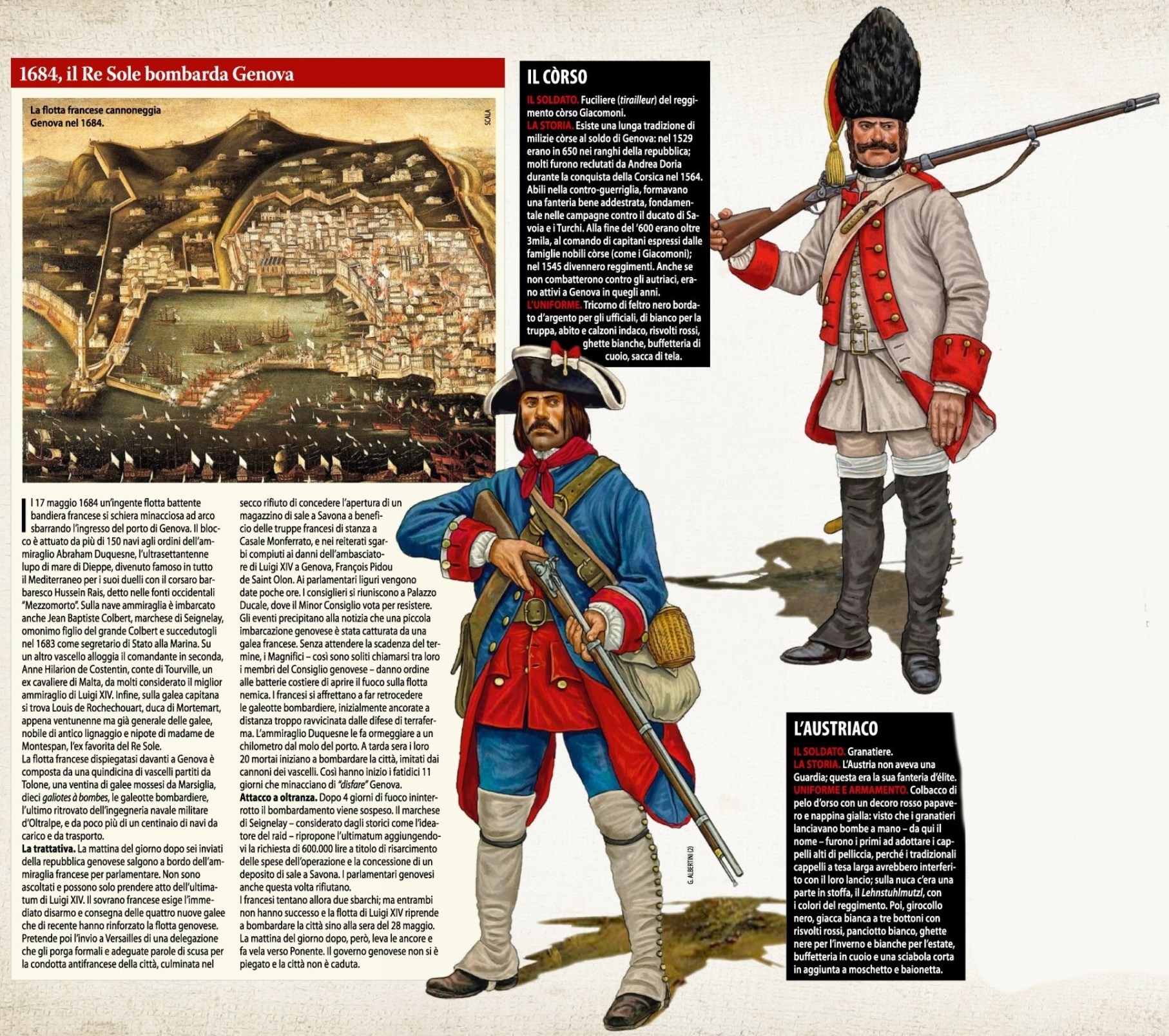
Italy and the naval
bombardment of Genoa in 1684
At the same time as Strasbourg was being swallowed up in the north, the
French appeared to give a clue to their sinister intentions elsewhere in Europe
when they occupied Casale, a fortress in the Montferrat forty miles east of
Turin. The Duke of Mantua was one of those hard-up petty potentates who
abounded at the time, and after being sounded by the French he willingly parted
with his enclave at Casale in return for a bribe.
It was bad enough that Louis got Casale at all, for it supplemented
Pinerolo as a base for French operations on the Italian side of the Alps. The
way in which the enterprise was carried out was more significant still, because
the occupying force and the subsequent reliefs marched straight across
Piedmontese territory without the formality of gaining the Duke of Savoy’s
leave. In a similarly cavalier fashion the French made a naval bombardment of
Genoa in 1684, simply because the republic appeared to be too friendly with
Spain. This drastic measure confirmed the impression that Louis regarded north
Italy as part of his own domains.
Piedmont and neighbouring states in the War of the Austrian Succession.
War of Austrian
Succession
At the beginning of 1745, during the War of Austrian
Succession the situation was altogether, in favor of the tenacious Maria
Theresa. France, however, had in the meantime found a new ally in Genvoa,
irritated by Piedmont and Austria for the threat to their possession of the
Finale (Treaty of Aranjuez May 7, 1745). With the help of the Genoese, the two
armies of the French-Spanish under Maillebois and Gages, came into Piedmont
from the Riviera and defeated the Austro-Piedmontese at Bassignana (September
28), then occupied successively Tortona, Piacenza, Parma, Pavia, Alessandria,
Asti and Casale, while Philip of Bourbon finally took Milan in December 19,
1745. In the Netherlands, France were dominant. The valiant Marshal Maurice de
Saxe won the Anglo-Dutch at Fontenay (11 May 1745) and occupied Tournai (May 22),
Ghent (July 10), Bruges (July 18), Oudenarde (July 21) and finally Ostend (July
23). To threaten England the French organized, in the summer of 1745, the
landing of Charles Edward Stuart in Scotland (August 4).
In Germany, the French influence was almost nil, while
England, threatened by Stuart, tried to reconcile once again Maria Theresa and
Frederick II. The latter, however, due to the stagnation of diplomatic
negotiations sort a military solution: won against the Austrians in Bohemia,
invaded Saxony, won the battle of Kesselsdorf (December 15), occupied Leipzig
and Dresden. So achieved his goal: Maria Teresa gave up Silesia and made peace
(Treaty of Dresden, December 25, 1745).
France was supported by Spain, Naples, Genoa, and Austria,
had as ally the kingdom of Sardinia, England, the Netherlands. The landing of
the Stuart in Scotland caused, in the autumn of 1745, a general uprising of the
Scots and caused terrible panic in London. But this uprising was ended with the
battle of Culloden (April 16, 1746). The only consequence was the opportunity,
given to Maurice of Saxony, to extend the involvement of the Austrian
Netherlands, beating an Austrian army in Rocoux in September, and threatening
Netherlands. On the other hand, Carlo Emanuele III took up the arms in
agreement with Maria Theresa. So he reoccupied Asti on March 8, 1746, expelled
the Franco-Hispanic armies from Piedmont and Lombardy, won in battle of
Piacenza (June 16), that caused the enemy’s retreat into Genoa. At this time,
the King Philip V of Spain died (July 9) and his successor, Ferdinand VI, was
inclined towards peace and the withdrawal of his troops from Italy. The
Austro-Sardinian pressed the enemy down on the Riviera, and Marshal Botta
Adorno, occupied Genoa on September 7, while Carlo Emanuele III blockaded
Savona, took Finale and pursued the Franco-Hispanic Army to Varo. Genoa
underwent three months of harsh occupation by Austria, but due to a violent
popular uprising, adroitly directed by the Genoese government (5-10 December
1746) freed itself.